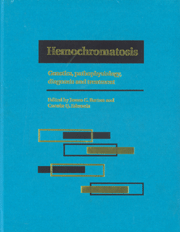Book contents
- Frontmatter
- Contents
- List of contributors
- Foreword
- Part I Introduction to hemochromatosis
- Part II Genetics of hemochromatosis
- Part III Metal absorption and metabolism in hemochromatosis
- Part IV Diagnostic techniques for iron overload
- Part V Complications of iron overload
- Part VI Therapy of hemochromatosis and iron overload
- Part VII Infections and immunity in hemochromatosis
- Part VIII Hemochromatosis heterozygotes
- Part IX Relationship of hemochromatosis to other disorders
- Part X Animal models of hemochromatosis and iron overload
- Part XI Screening for hemochromatosis
- Part XII Hemochromatosis: societal and ethical issues
- 52 Hemochromatosis: effect of iron fortification of foods
- 53 Evidence for population-based testing for hemochromatosis
- 54 Ethical issues and hemochromatosis
- 55 Hemochromatosis patients as blood and tissue donors
- 56 Genetic counseling for hemochromatosis
- Part XIII Final issues
- Index
53 - Evidence for population-based testing for hemochromatosis
from Part XII - Hemochromatosis: societal and ethical issues
Published online by Cambridge University Press: 05 August 2011
- Frontmatter
- Contents
- List of contributors
- Foreword
- Part I Introduction to hemochromatosis
- Part II Genetics of hemochromatosis
- Part III Metal absorption and metabolism in hemochromatosis
- Part IV Diagnostic techniques for iron overload
- Part V Complications of iron overload
- Part VI Therapy of hemochromatosis and iron overload
- Part VII Infections and immunity in hemochromatosis
- Part VIII Hemochromatosis heterozygotes
- Part IX Relationship of hemochromatosis to other disorders
- Part X Animal models of hemochromatosis and iron overload
- Part XI Screening for hemochromatosis
- Part XII Hemochromatosis: societal and ethical issues
- 52 Hemochromatosis: effect of iron fortification of foods
- 53 Evidence for population-based testing for hemochromatosis
- 54 Ethical issues and hemochromatosis
- 55 Hemochromatosis patients as blood and tissue donors
- 56 Genetic counseling for hemochromatosis
- Part XIII Final issues
- Index
Summary
Introduction
As many as 1 million persons in the United States are affected by hemochromatosis, a genetic condition characterized by excess iron absorption and pathologic iron deposition in tissue. If undetected and untreated, hemochromatosis can result in illness (such as cirrhosis, hepatoma, diabetes, cardiomyopathy, arthritis, arthropathy, and hypopituitarism with hypogonadism) and death. The identification and treatment of asymptomatic persons in whom iron measures are elevated but hemochromatosis is not clinically apparent have been recommended as a potentially cost-effective strategy for preventing hemochromatosis-associated illness and death. Nonetheless, some experts argue that before universal screening can be recommended, the clinical expression and natural history of hemochromatosis must be clarified and the infrastructure necessary to support a universal screening program (including laboratory standardization and physician education) must be established. The recent discovery of a gene associated with hemochromatosis has made it possible to use DNA testing along with, or instead of, iron measures in screening. Although this discovery has increased interest in hemochromatosis, it has also raised new questions about screening for and diagnosis of the disease. One objective of the meeting on Iron Overload, Public Health, and Genetics, sponsored by the Centers for Disease Control and Prevention and the National Institutes of Health in March 1997, was to review the scientific information available on population screening for hemochromatosis. Our assessment of the evidence and recommendations for action are presented here.
Methods for evaluating the evidence for population screening for hemochromatosis
US Preventive Services Task Force criteria were used15 to evaluate evidence related to population screening for hemochromatosis that was presented at the meeting on Iron Overload, Public Health and Genetics or was published before August 1997.
- Type
- Chapter
- Information
- HemochromatosisGenetics, Pathophysiology, Diagnosis and Treatment, pp. 544 - 554Publisher: Cambridge University PressPrint publication year: 2000



